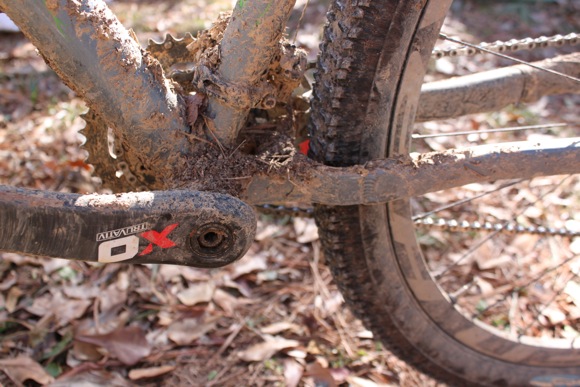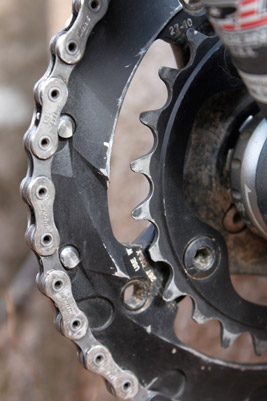Almost every brand new mountain bike drivetrain I’ve ridden has been great: quiet operation, smooth shifting, and shiny parts – heck, even the lube on a new drivetrain smells great. But over time things usually start to go south – derailleurs wilt, cassettes choke on grime, and bottom brackets start to creak; cranks lose their teeth and chains start to kink. Regular maintenance can certainly delay the decay but the real key is to start with high performance design and quality parts that are built to last and can stand up to trail abuse. The SRAM X0 series takes this idea and rides with it to a whole new level.
I’ve been testing the new SRAM X0 2×10 drivetrain on my 29er over the last 6 months, quickly taking things from “factory fresh” to “well worn” and I’ve learned a lot about X0 and 2×10 along the way. Just this month I finished riding 29 trails in 29 days in some of the worst mountain bike conditions imaginable – snow, mud, ice, and rain – which was great for testing (though not always great for riding). Here’s what I found.
SRAM XX Cassette
Yes, this is a review of the SRAM X0 drivetrain but at the time I received my parts the X0 cassette (XG 1080) was still in production so I got hooked up with the XG 1099 (score!). I know it’s been said before but the SRAM XX cassette is truly a work of art. According to SRAM, it takes 9 hours to cut the cassette out of a solid hunk of steel using fancy CNC machinery. The result is a one-piece design that’s been digitally optimized for maximum mud shedding, light weight, precision, and strength.
I opted for the 11-36 cassette (there’s also a more aggressive 11-32 version) which weighs 31 grams less than the already supermodel-thin X0 cassette. The final 11T ring is separate from the main cassette body as is the aluminum lock ring. Just like the X7, X9, and X0 cassettes, the XG 1099 features SRAM’s X-Glide technology which provides consistent shifting performance under a variety of conditions.
Installing and uninstalling the XX cassette has been a breeze. At this point I’ve used the cassette with 3 different wheel sets and I’ve cleaned/degreased it just as many times. It’s always a smooth fit and after a recent cleaning it still looked as good as new (the pic directly above is an “after” shot taken a few days ago; the pic at the top of the article was taken “before”).
It’s tough to talk about the performance of a single component in a mountain bike drivetrain, especially the cassette where the rear derailleur mostly runs the show. I can say my chain never slipped (not surprising) and that mud shedding is certainly above average. Leaves and various bits of crud did manage to find their way into the cassette voids over time but were easy enough to remove with running water and a toothpick.
GXP Team Bottom Bracket
The bottom bracket is sorta the unsung hero of any drivetrain but the GXP Team Bottom Bracket is hard to ignore. With sealed steel bearings and a tungsten finish, the GXP Bottom Bracket is built to keep water and crud out while maintaining a velvety smooth spin. Mine installed easily and I haven’t had to touch it since. Over the past six months I’ve been cranking the pedals pretty hard and the BB continues to whirl like new.
SRAM X0 Crankset
The X0 crankset is perhaps my favorite part of the whole drivetrain setup. With carbon crank arms and the simplicity of just two rings up front, the X0 really shines. I went with the 26-39 configuration but SRAM also offers a racy 28-42 2×10 option as well as a 3-ring 22-33-44 version (these options are also available in the X7 and X9 lines). Like the cassette, the crank rings are CNC-machined for sharp precision and a sexy look and feel.
Some riders may be wondering about the differences between X0 and X9 parts and the answer really depends on which component you’re talking about. The X0 crankset, for example, weighs in at 788 grams compared to the (aluminum) X9 at 881 grams (that’s almost 100 grams lighter for the math-challenged). It’s a pretty significant difference and in my opinion, worth the additional investment. If you do have to skimp somewhere, consider another area like the chain.
The biggest question most mountain bikers have about going 2×10 is whether they’ll miss the third chain ring. I personally love the simplicity of a 2-ring set-up and while some of the most extreme “granny gears” are missing, I found that I was quickly able to adapt. On the high end I only miss the additional gears when I’m riding flat stuff like fireroads or pavement (and I try to limit that as much as I can anyway!). A 2×10 drivetrain doesn’t quite offer the same range of gearing as a standard 3x system – but it gets close enough for any rider who appreciates things like simplicity and weight savings.
As with any long term relationship, mountain bikers tend to hurt the ones they love the most and unfortunately the X0 crankset has born the brunt of my trail abuse. During a nighttime time trial in Augusta one of my pedals worked itself loose and when I stepped on it coming out of a turn I stripped the last 2-3 pedal threads on the crank. The loose pedal had nothing to do with the crank itself – the pedal either wasn’t tightened properly or it seized in the cold temps – which made the damage all the more frustrating. Fortunately I was able to have the threads re-tapped and after a month of riding and hundreds of miles, everything is holding up well.
Coming off a 1×9 drivetrain, I also haven’t done a good job protecting my big ring from log hits. During a recent inspection I found one big ring tooth that was nearly completely gone and a few others that had been noticeably dulled. To be honest I haven’t noticed any performance issues associated with the loss but I’ll certainly be more careful and will do a better job removing grit from my chain after muddy rides to avoid further wear on the precision metal teeth.
SRAM PowerChain 1071
Some may be surprised to learn that standard 9spd chains won’t work well with a 2×10 drivetrain and it’s because the spacing on a 10spd cassette is slightly narrower. The PowerChain 1071 is actually part of the X7 group and the only difference between the 1071 and 1091R (the X0/XX chain) seems to be the “Lighting Holes” the 1091R features on outer links for additional weight savings. How much weight do the holes save? According to SRAM, about 2 grams (less than 1% of the total).
SRAM’s 10spd chains also feature the PowerLock connecting link that’s a little different from the PowerLink connection you’ll find on SRAM 9spd chains. PowerLock links can be installed without using a tool but unlike PowerLinks, they are not re-usable (the pins pop off when you use a standard chain removal tool). I haven’t had any issues with my chain over the past 500+ miles but I always carry a couple spare PowerLocks in my hydration pack just in case.
Despite the narrower chain gauge I haven’t noticed any unusual side-to-side flex during shifting nor have I experienced any sort of “chain stretch.” Keeping the chain clean and properly lubed seems to make all the difference in terms of quiet performance. The only thing I’ve noticed is that my rag catches slightly on the PowerLock link when I wipe off excess lube.
So that’s a lot to take in and I haven’t even talked about the shifters or derailleurs (coming up next). Look for part II of my review plus a review of SRAM’s sexy X0 hydraulic disc brakes.
Thanks to the folks at SRAM for providing these parts for testing and review.


























